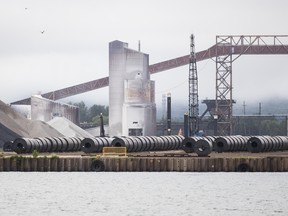
Article content
Canadian steelmakers might need to pivot their focus on the domestic industry as steep tariffs lock them out of the United States market, according to the chief executive of Canada’s second-largest steel producer.
THIS CONTENT IS RESERVED FOR SUBSCRIBERS ONLY
Subscribe now to read the latest news in your city and across Canada.
- Exclusive articles from Barbara Shecter, Joe O'Connor, Gabriel Friedman, and others.
- Daily content from Financial Times, the world's leading global business publication.
- Unlimited online access to read articles from Financial Post, National Post and 15 news sites across Canada with one account.
- National Post ePaper, an electronic replica of the print edition to view on any device, share and comment on.
- Daily puzzles, including the New York Times Crossword.
SUBSCRIBE TO UNLOCK MORE ARTICLES
Subscribe now to read the latest news in your city and across Canada.
- Exclusive articles from Barbara Shecter, Joe O'Connor, Gabriel Friedman and others.
- Daily content from Financial Times, the world's leading global business publication.
- Unlimited online access to read articles from Financial Post, National Post and 15 news sites across Canada with one account.
- National Post ePaper, an electronic replica of the print edition to view on any device, share and comment on.
- Daily puzzles, including the New York Times Crossword.
REGISTER / SIGN IN TO UNLOCK MORE ARTICLES
Create an account or sign in to continue with your reading experience.
- Access articles from across Canada with one account.
- Share your thoughts and join the conversation in the comments.
- Enjoy additional articles per month.
- Get email updates from your favourite authors.
THIS ARTICLE IS FREE TO READ REGISTER TO UNLOCK.
Create an account or sign in to continue with your reading experience.
- Access articles from across Canada with one account
- Share your thoughts and join the conversation in the comments
- Enjoy additional articles per month
- Get email updates from your favourite authors
Sign In or Create an Account
or
Article content
“We’ll have little to no business in the U.S. if the 50 per cent tariff continues,” Algoma Steel Inc. CEO Michael Garcia said in a recent interview with the Financial Post’s Larysa Harapyn. “Once the full effect of (the tariffs) plays out, it will effectively lock out Algoma and frankly other Canadian steel producers from the U.S. market.”
Article content
Article content
Article content
Garcia said not having economic access to customers in the U.S. would be a big challenge for Canadian steelmakers because that’s where most of their product goes. “There really are no practical foreign markets for Canadian steel other than the U.S. market,” he said.
Article content
By signing up you consent to receive the above newsletter from Postmedia Network Inc.
Article content
But entering the domestic market comes with its own obstacles. Garcia said roughly two-thirds of the country’s steel is supplied by foreign companies, so Canadian steelmakers would face a lot of competition.
Article content
“Much of that steel is unfairly traded and dumped into the Canadian market,” he said. “That’s accelerated now that the U.S. has 50 per cent tariffs on all foreign steel coming into the U.S.”
Article content
Garcia said another problem is that most of the steel produced domestically is coil, and steelmakers would need to diversify their product to appeal to Canadian businesses.
Article content
“That requires investment, that requires time,” he said. “There has to be an environment where Canadian steelmakers are making the … type of steel that is consumed in Canada and have a free-trade environment to win that business.”
Article content
The federal government said last month that it is setting aside $1 billion from its Strategic Innovation Fund to help Canadian steel companies advance new projects. But Garcia said there isn’t an uptick in demand for those projects yet.
Article content
“Our challenge is to bridge the company into the future,” he said. “Make sure we’re making the right type of products, that are demanded by Canadian customers, and be there when that demand appears.”
Article content
Article content

.jpg) 7 hours ago
3
7 hours ago
3
 English (US)
English (US)